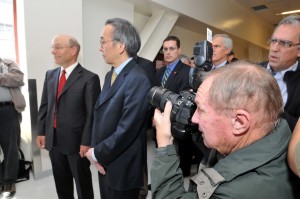I joined the Albuquerque Journal in 1990 in what I now think of as “the golden age of journalism”. That’s shorthand for reliable access to expense account travel, but something more. If, as it often was, the story happened to be at a nuclear waste dump in southeastern New Mexico, or at an Air Force Base on the eastern plains, or a paleontological dig in the bootheel, a writer and a photographer would jump in a Ford Bronco and go. I do not, by this, mean luxurious or extravagant expense account travel. The Flume, the restaurant at the Stevens Inn in Carlsbad, New Mexico, is not an extravagant place. The extravagance was in the time, the freedom to go to places and spend time learning and thinking about them, a freedom that the culture and economics of the 21st century newspaper has constrained.
Those writers who did these things at the Albuquerque Journal at that moment in history almost always did them with a photographer named Richard Pipes. For many years, Richard was the Journal’s road trip guy. The scheduling ritual was hilarious. If we wanted to plan a trip, we’d first check with the other road trip reporters to see who needed Richard when.
Richard was a pro, by which I mean two things. First, he always came back with the pictures we needed to tell our story. Second, he always knew where to eat, and always took responsibility for putting the meals on his company credit card. I was young and nervous about my place in the organization, and my place in the business of making news for readers. On both counts – getting the news, and justifying the expense reports – Richard gave me confidence.
Richard taught me some basic rules of journalism that have held me in good stead:
- Eat when you can.
- Pee when you can.
- Always bring something to read.
But here is the most important thing I learned. When we got to a place, Richard would go through his ritual of assembling the camera gear – two camera bodies, more lenses, film (yes). Then there was a second phase of the ritual that I was slow to grasp but, once learned, became the most important thing Richard taught me. His eyes would dart around, looking for the first picture, and he wouldn’t relax until he was sure he had at least one thing in the camera that would work. Then he would settle, and we’d keep working for hours (sometimes days) in an easier rhythm. But he was never quite happy until that moment when he knew he had an image that would carry us if suddenly we had to stop working and go home. Once you’ve got that, you can always make it better, but you never come home empty handed.
Richard was one of many photographers I’ve worked with in my years as a journalist, relationships that I treasure. There is something about the bond of writer and photographer collaborating on a story, and I don’t mean to single out Richard’s skills here as a photojournalist. Richard’s place was special to me because he was at my side during a most important time in my life, teaching me and taking pictures for my stories and putting our dinner on the company card.
Richard died Sunday. Sad face.
updated 7/24/2015 with a nice picture Randy Montoya sent me of Richard working


I loved this one. So sorry about your colleague.
Thank you for this John. And condolences.
Best,
D
some of our friends leave us way too soon.
Pingback: Richard Pipes, workin' it - jfleck at inkstain
a lovely tribute to a lovely man, who was always so present and kind, and so I’ll be the one to say his photojournalism always moved me.
I’m sad to learn Richard died this past week. Thanks for the lovely tribute. I also enjoyed working with him and hearing his stories from the golden age.
My first Pipes excursion was to Grants circa 1975. He’d heard that the constant rumbling of uranium mining machinery and trucks was slowly eroding the home where Lew Wallace wrote Ben Hur, so we went to check it out. That wasn’t exactly true, but we got a story and great art. Our first meal together was grilled lamb and beans with a sheep shearing crew on the Lee Ranch out there. A great guy to be with on a long car trip.
Very well said, John.
Hearing about Richard’s passing has left me shocked and saddened. Not only was Richard an excellent photographer, he knew his way around New Mexico better than anyone I know. From Alamogordo to Two Grey Hills, Richard knew of every rut on every road. He is missed.
He was a wonderful photographer and a decent human being.
Richard and the era were a great match. It’s a significant loss for Journal readers that both are now gone. Thanks for sharing how it was and who he was.
Great words John for a superb craftsman.
Thank you John. My condolences to you and all of his family and friends.
Thank you, John, for sharing this. Richard was a quintessential photojournalist and I am happy to have known him.
Thank you, John, for posting this. It always seems I’ve learned critical advice from photographers during my career. Each time I went out with Richard on assignment, I learned something new. I am lucky to have known him.
We all have our stories about Pipes, the name by which he was called in the newsroom, but I think what most impressed me was his incredible ability to tell the story with pictures; he inspired me to strive to do the same with my text, and sometimes when I succeeded, he’d privately comment to me, “Good story,” and it meant the world to me.
What Arley said.
Loved this John.